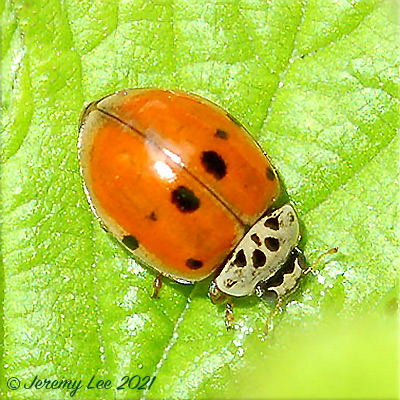
 |
|
Scientific Classifications explained » Amphibians » Ants » Aphids » Bees » Beetles » Birds » Bugs » Butterflies » Caterpillars » Damselflies » Dragonflies » Earwigs » Flies » Frog/Leafhoppers » Fungi » Galls » Grasshoppers » Harvestmen » Hoverflies » Lacewings » Ladybirds » Leaf Mines » Lichens » Mammals » Millipedes » Mosses » Moths » Sawflies » Slugs » Snails » Spiders » Trees & Shrubs » Wasps » Wild Flowers » Woodlice » Postboxes |
UK Nature > Ladybirds > Adalia decempunctata

Scientific Name: Adalia decempunctata Common Name: 10-Spot Ladybird Adalia decempunctata, more commonly known as the 10-spot ladybird, is a small and variable ladybird - which confusingly doesn't always have 10 spots. Newly hatched specimens take a while to develop the orange background colour and appear more like a pale brown. The legs are orange on this species which is a helpful guide to identification. Though variable, the various colour forms are all identifiable - the specimen in my photograph is the A.octopunctata variant. Found in woodland, and gardens with trees, active from March to October. Both adults and larvae feed on aphids and are useful in keeping these down. They often hibernate in huge aggregations in sheds or under loose tree bark. Very common throughout Britain though less so in the far north. |
|

https://www.uknature.co.uk is a website dedicated to showing the immense diversity of UK nature and wildlife. Our vast range of habitats, from lowland arable to snow covered mountains, from storm-ravaged coastlines to peaceful inland freshwater lakes and rivers, from dry, sandy heaths to deciduous and coniferous forests, all these habitats contribute to the abundance of UK nature. We have wild birds in huge numbers either residing or visiting our shores (597 recorded species as at July 2013) and we must also not forget the humble back garden with its grass lawns, flower beds filled with nectar rich flowers, shrubs and trees, all designed to attract huge numbers of insects such as bees, moths, butterflies and hoverflies; and finally the small ponds which provide safe havens for frogs, toads, newts and even slow worms and grass snakes. www.uknature.co.uk is the showcase for my personal passion, photographing uknature in all its glory. I sincerely hope you all enjoy the fruits of my labours. This site and all images contained therein is © Jeremy Lee 2004 - 2025. All Rights Reserved. Site design by Jeremy Lee. Site development & IT Support by Stuart Lee. |